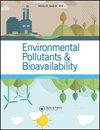水葫芦积累过程中镉结合形式的鉴定
Q3 Chemical Engineering
引用次数: 2
摘要
摘要:众所周知,植物具有超积累能力,但尽管它们广泛用于环境中的水净化,但这种现象的本质尚不清楚。本文以镉和水葫芦为例,介绍了植物中金属多肽结合形式测定方法的发展。建议的方法是先提取分析物,然后用紫外和元素选择性检测进行高效液相色谱分离,最后测定含镉分离组分中的氨基酸和硫化物基团,并为此制定了微柱色谱仪和ICP-OES光谱仪的最佳接口参数。结果表明,含镉化合物可归因于与植物螯合素类似的肽。这种方法提供了有关在生物积累过程中负责解毒行为的化合物性质的信息。本文章由计算机程序翻译,如有差异,请以英文原文为准。
Identification of the binding forms of cadmium during accumulation by water hyacinth
Abstract It is well known that the plants are capable to hyperaccumulation but despite their extensive use for water cleaning in environment, the essence of this phenomenon remains unclear. This paper is focused on the development of methodology for the determination of peptides binding forms of the metal in plants on the example of cadmium and water hyacinth. The suggested approach is based on the analytes extraction followed by their HPLC separation with UV and element-selective detection, and at last amino acids and sulfide groups determination in the isolated fractions containing cadmium, and for this, the optimal parameters for the interfacing of microcolumn chromatograph and ICP-OES spectrometer have been developed. It has been shown as a result that cadmium-containing compounds can be attributed to peptides similar to phytochelatins. This approach provides an information concerning the nature of the compounds responsible for the act of detoxification during bioaccumulation process.
求助全文
通过发布文献求助,成功后即可免费获取论文全文。
去求助
来源期刊
CiteScore
1.62
自引率
0.00%
发文量
0
审稿时长
1 months
期刊介绍:
Chemical Speciation & Bioavailability ( CS&B) is a scholarly, peer-reviewed forum for insights on the chemical aspects of occurrence, distribution, transport, transformation, transfer, fate, and effects of substances in the environment and biota, and their impacts on the uptake of the substances by living organisms. Substances of interests include both beneficial and toxic ones, especially nutrients, heavy metals, persistent organic pollutants, and emerging contaminants, such as engineered nanomaterials, as well as pharmaceuticals and personal-care products as pollutants. It is the aim of this Journal to develop an international community of experienced colleagues to promote the research, discussion, review, and spread of information on chemical speciation and bioavailability, which is a topic of interest to researchers in many disciplines, including environmental, chemical, biological, food, medical, toxicology, and health sciences.
Key themes in the scope of the Journal include, but are not limited to, the following “6Ms”:
Methods for speciation analysis and the evaluation of bioavailability, especially the development, validation, and application of novel methods and techniques.
Media that sustain the processes of release, distribution, transformation, and transfer of chemical speciation; of particular interest are emerging contaminants, such as engineered nanomaterials, pharmaceuticals, and personal-care products.
Mobility of substance species in environment and biota, either spatially or temporally.
Matters that influence the chemical speciation and bioavailability, mainly environmentally relevant conditions.
Mechanisms that govern the transport, transformation, transfer, and fate of chemical speciation in the environment, and the biouptake of substances.
Models for the simulation of chemical speciation and bioavailability, and for the prediction of toxicity.
Chemical Speciation & Bioavailability is a fully open access journal. This means all submitted articles will, if accepted, be available for anyone to read, anywhere, at any time. immediately on publication. There are no charges for submission to this journal.

 求助内容:
求助内容: 应助结果提醒方式:
应助结果提醒方式:


